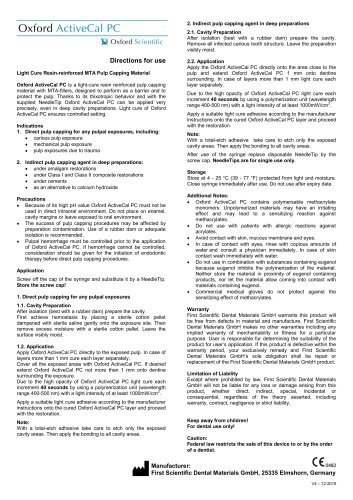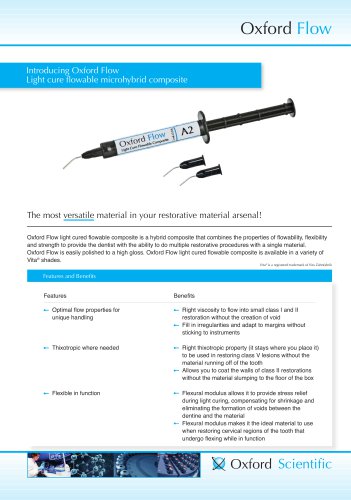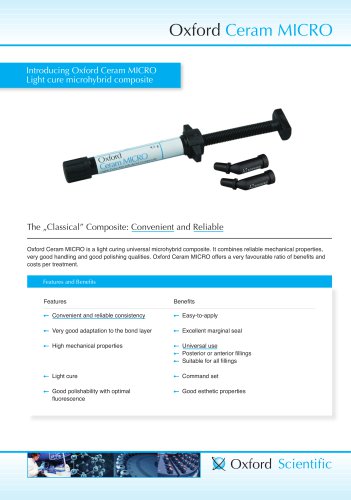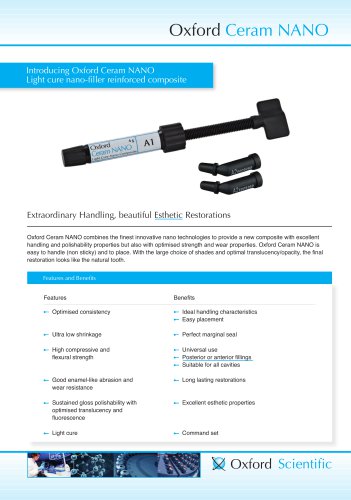Catalog excerpts

2. Indirect pulp capping agent in deep preparations 2.1. Cavity Preparation After isolation (best with a rubber dam) prepare the cavity. Remove all infected carious tooth structure. Leave the preparation visibly moist. Directions for use Light Cure Resin-reinforced MTA Pulp Capping Material Oxford ActiveCal PC is a light-cure resin reinforced pulp capping material with MTA-fillers, designed to perform as a barrier and to protect the pulp. Thanks to its thixotropic behavior and with the supplied NeedleTip Oxford ActiveCal PC can be applied very precisely, even in deep cavity preparations. Light cure of Oxford ActiveCal PC ensures controlled setting. Indications 1. Direct pulp capping for any pulpal exposures, including: carious pulp exposure mechanical pulp exposure pulp exposures due to trauma 2. Indirect pulp capping agent in deep preparations: under amalgam restorations under Class I and Class II composite restorations under cements as an alternative to calcium hydroxide 2.2. Application Apply the Oxford ActiveCal PC directly onto the area close to the pulp and extend Oxford ActiveCal PC 1 mm onto dentine surrounding. In case of layers more than 1 mm light cure each layer separately. Due to the high opacity of Oxford ActiveCal PC light cure each increment 40 seconds by using a polymerization unit (wavelength range 400-500 nm) with a light intensity of at least 1000mW/cm 2. Apply a suitable light cure adhesive according to the manufacturer instructions onto the cured Oxford ActiveCal PC layer and proceed with the restoration. Note: With a total-etch adhesive take care to etch only the exposed cavity areas. Then apply the bonding to all cavity areas. After use of the syringe replace disposable NeedleTip by the screw cap. NeedleTips are for single use only. Storage Store at 4 - 25 °C (39 - 77 °F) protected from light and moisture. Close syringe immediately after use. Do not use after expiry date. Precautions Because of its high pH value Oxford ActiveCal PC must not be used in direct intraoral environment. Do not place on enamel, cavity margins or leave exposed to oral environment. The success of pulp capping procedures may be affected by preparation contamination. Use of a rubber dam or adequate isolation is recommended. Pulpal hemorrhage must be controlled prior to the application of Oxford ActiveCal PC. If hemorrhage cannot be controlled, consideration should be given for the initiation of endodontic therapy before direct pulp capping procedures. Application Screw off the cap of the syringe and substitute it by a NeedleTip. Store the screw cap! 1. Direct pulp capping for any pulpal exposures 1.1. Cavity Preparation After isolation (best with a rubber dam) prepare the cavity. First achieve hemostasis by placing a sterile cotton pellet dampened with sterile saline gently onto the exposure site. Then remove excess moisture with a sterile cotton pellet. Leave the surface visibly moist. 1.2. Application Apply Oxford ActiveCal PC directly to the exposed pulp. In case of layers more than 1 mm cure each layer separately. Cover all the exposed areas with Oxford ActiveCal PC. If desired extend Oxford ActiveCal PC not more than 1 mm onto dentine surrounding the exposure. Due to the high opacity of Oxford ActiveCal PC light cure each increment 40 seconds by using a polymerization unit (wavelength range 400-500 nm) with a light intensity of at least 1000mW/cm 2. Apply a suitable light cure adhesive according to the manufacturer instructions onto the cured Oxford ActiveCal PC layer and proceed with the restoration. Note: With a total-etch adhesive take care to etch only the exposed cavity areas. Then apply the bonding to all cavity areas. Additional Notes: Oxford ActiveCal PC contains polymersable methacrylate monomers. Unpolymerized materials may have an irritating effect and may lead to a sensitizing reaction against methacrylates. Do not use with patients with allergic reactions against acrylates. Avoid contact with skin, mucous membrane and eyes. In case of contact with eyes, rinse with copious amounts of water and consult a physician immediately. In case of skin contact wash immediately with water. Do not use in combination with substances containing eugenol because eugenol inhibits the polymerization of the material. Neither store the material in proximity of eugenol containing products, nor let the material allow coming into contact with materials containing eugenol. Commercial medical gloves do not protect against the sensitizing effect of methacrylates. Warranty First Scientific Dental Materials GmbH warrants this product will be free from defects in material and manufacture. First Scientific Dental Materials GmbH makes no other warranties including any implied warranty of merchantability or fitness for a particular purpose. User is responsible for determining the suitability of the product for user’s application. If this product is defective within the warranty period, your exclusively remedy and First Scientific Dental Materials GmbH’s sole obligation shall be repair or replacement of the First Scientific Dental Materials GmbH product. Limitation of Liability Except where prohibited by law, First Scientific Dental Materials GmbH will not be liable for any loss or damage arising from this product, whether direct, indirect, special, incidental or consequential, regardless of the theory asserted, including warranty, contract, negligence or strict liability. Keep away from children! For dental use only! Caution: Federal law restricts the sale of this device to or by the order of a dentist. Manufacturer: First Scientific Dental Materials GmbH, 25335 Elmshorn, Germany V4 – 12
Open the catalog to page 1All First Scientific Dental Materials GmbH catalogs and technical brochures
-
Oxford Scientific 2019
44 Pages






